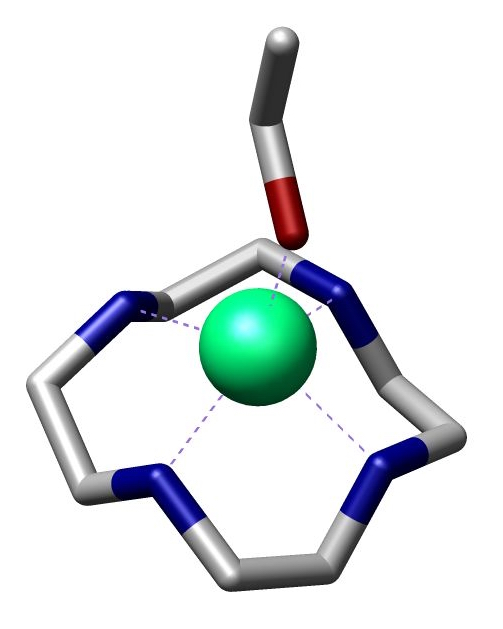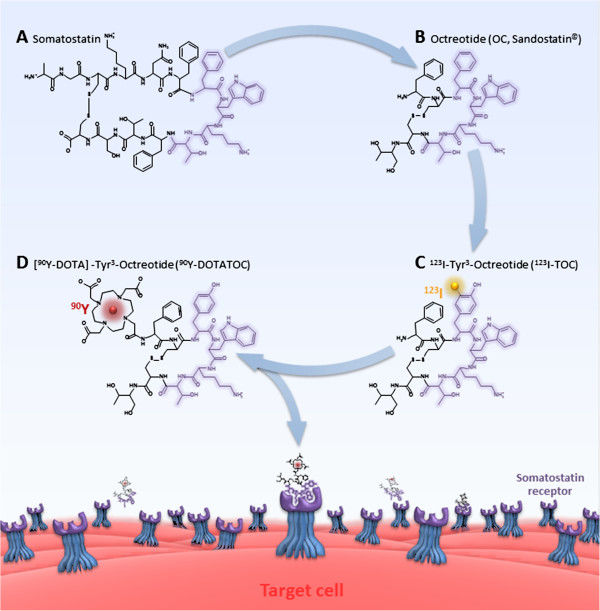|
DOTA (chelator)
DOTA (also known as tetraxetan) is an organic compound with the formula (CH2CH2NCH2CO2H)4. The molecule consists of a central 12-membered tetraaza (i.e., containing four nitrogen atoms) ring. DOTA is used as a complexing agent, especially for lanthanide ions. Its complexes have medical applications as contrast agents and cancer treatments. Terminology The acronym DOTA (for dodecane tetraacetic acid) is shorthand for both the tetracarboxylic acid and its various conjugate bases. In the area of coordination chemistry, the tetraacid is called H4DOTA and its fully deprotonated derivative is DOTA4−. Many related ligands are referred to using the DOTA acronym, although these derivatives are generally not ''tetra''carboxylic acids or the conjugate bases. Structure DOTA is derived from the macrocycle known as cyclen. The four secondary amine groups are modified by replacement of the N-H centers with N-CH2CO2H groups. The resulting aminopolycarboxylic acid, upon ionization of the carb ... [...More Info...] [...Related Items...] OR: [Wikipedia] [Google] [Baidu] |
Cyclen
Cyclen (1,4,7,10-tetraazacyclododecane) is a aza-crown ether with the formula (CH2CH2NH)4. It is a white solid. Synthesis Some syntheses exploit the Thorpe-Ingold effect to facilitate ring-formation. Illustrative is the reaction of the deprotonated tosylamides with ditosylates: :TsN(CH2CH2NTsNa)2 + TsN(CH2CH2OTs)2 → (TsNCH2CH2)4 The resulting macrocycle can be deprotected with strong acid. Base gives the tetramine. High dilution conditions result in a low reaction rate penalty and this disadvantage is removed in an alternative procedure starting from triethylenetetraamine and dithiooxamide to a bisamidine – also a bis(imidazoline) – followed by reduction and ring expansion with DIBAL. : In one study cyclen is covalently bonded through a propylene molecular spacer to adenine and chelated with zinc diperchlorate. This complex is able to selectively bind uracil and uridine in a 1:2 ratio both through the adenine part and cyclen part of the molecule as evi ... [...More Info...] [...Related Items...] OR: [Wikipedia] [Google] [Baidu] |
American Medical Association
The American Medical Association (AMA) is a professional association and lobbying group of physicians and medical students. Founded in 1847, it is headquartered in Chicago, Illinois. Membership was approximately 240,000 in 2016. The AMA's stated mission is "to promote the art and science of medicine and the betterment of public health." The Association also publishes the ''Journal of the American Medical Association'' (JAMA). The AMA also publishes a list of Physician Specialty Codes which are the standard method in the U.S. for identifying physician and practice specialties. The American Medical Association is governed by a House of Delegates as well as a board of trustees in addition to executive management. The organization maintains the AMA Code of Medical Ethics, and the AMA Physician Masterfile containing data on United States Physicians. The ''Current Procedural Terminology'' coding system was first published in 1966 and is maintained by the Association. It has also publi ... [...More Info...] [...Related Items...] OR: [Wikipedia] [Google] [Baidu] |
Gadolinium
Gadolinium is a chemical element with the symbol Gd and atomic number 64. Gadolinium is a silvery-white metal when oxidation is removed. It is only slightly malleable and is a ductile rare-earth element. Gadolinium reacts with atmospheric oxygen or moisture slowly to form a black coating. Gadolinium below its Curie point of is ferromagnetic, with an attraction to a magnetic field higher than that of nickel. Above this temperature it is the most paramagnetic element. It is found in nature only in an oxidized form. When separated, it usually has impurities of the other rare-earths because of their similar chemical properties. Gadolinium was discovered in 1880 by Jean Charles de Marignac, who detected its oxide by using spectroscopy. It is named after the mineral gadolinite, one of the minerals in which gadolinium is found, itself named for the Finnish chemist Johan Gadolin. Pure gadolinium was first isolated by the chemist Paul-Émile Lecoq de Boisbaudran around 1886. Gadoliniu ... [...More Info...] [...Related Items...] OR: [Wikipedia] [Google] [Baidu] |
Yttrium-90
Yttrium-90 () is an isotope of yttrium. Yttrium-90 has found a wide range of uses in radiation therapy to treat some forms of cancer. Decay undergoes β− decay to zirconium-90 with a half-life of 64.1 hours and a decay energy of 2.28 MeV with an average beta energy of 0.9336 MeV. It also produces 0.01% 1.7 MeV photons during its decay process to the 0+ state of 90Zr, followed by pair production. The interaction between emitted electrons and matter can lead to the emission of Bremsstrahlung radiation. Production Yttrium-90 is produced by the nuclear decay of strontium-90 which has a half-life of nearly 29 years and is a fission product of uranium used in nuclear reactors. As the strontium-90 decays, chemical high-purity separation is used to isolate the yttrium-90 before precipitation. Medical application 90Y plays a significant role in the treatment of hepatocellular carcinoma (HCC), leukemia, and lymphoma, although it has the potential to treat a range of tumo ... [...More Info...] [...Related Items...] OR: [Wikipedia] [Google] [Baidu] |
Tacatuzumab
Yttrium (90Y) tacatuzumab tetraxetan (trade name AFP-Cide) is a humanized monoclonal antibody intended for the treatment of cancer. The antibody itself, tacatuzumab, is conjugated with tetraxetan, a chelator for yttrium-90, a radioisotope A radionuclide (radioactive nuclide, radioisotope or radioactive isotope) is a nuclide that has excess nuclear energy, making it unstable. This excess energy can be used in one of three ways: emitted from the nucleus as gamma radiation; transferr ... which destroys the tumour cells. References Monoclonal antibodies for tumors Antibody-drug conjugates Radiopharmaceuticals Yttrium compounds Experimental cancer drugs DOTA (chelator) derivatives {{antineoplastic-drug-stub ... [...More Info...] [...Related Items...] OR: [Wikipedia] [Google] [Baidu] |
DOTA-biotin
90Y-DOTA-biotin consists of a radioactive substance (yttrium-90) complexed by a chelating agent (DOTA), which in turn is attached to the vitamin biotin via a chemical linker. It is used experimentally in pretargeted radioimmunotherapy. Animal studies have been conducted as well as clinical studies in humans. In pretargeted radioimmunotherapy, two or three medications are applied in succession. At first, an antibody-drug conjugate is administered, which consists of a monoclonal antibody designed to target the tumour, and a chemical marker which in the case of DOTA-biotin therapy is one of the proteins avidin and streptavidin Streptavidin is a 66.0 (tetramer) kDa protein purified from the bacterium '' Streptomyces avidinii''. Streptavidin homo-tetramers have an extraordinarily high affinity for biotin (also known as vitamin B7 or vitamin H). With a dissociation co .... After a time of typically one or two days to let the antibody accumulate in the tumour, a clearing agent may b ... [...More Info...] [...Related Items...] OR: [Wikipedia] [Google] [Baidu] |
Avidin
Avidin is a tetrameric biotin-binding protein produced in the oviducts of birds, reptiles and amphibians and deposited in the whites of their eggs. Dimeric members of the avidin family are also found in some bacteria. In chicken egg white, avidin makes up approximately 0.05% of total protein (approximately 1800 μg per egg). The tetrameric protein contains four identical subunits (homotetramer), each of which can bind to biotin (Vitamin B7, vitamin H) with a high degree of affinity and specificity. The dissociation constant of the avidin-biotin complex is measured to be ''K''D ≈ 10−15 M, making it one of the strongest known non-covalent bonds. In its tetrameric form, avidin is estimated to be 66–69 k Da in size. 10% of the molecular weight is contributed by carbohydrate, composed of four to five mannose and three N-acetylglucosamine residues The carbohydrate moieties of avidin contain at least three unique oligosaccharide structural types that are similar in structure ... [...More Info...] [...Related Items...] OR: [Wikipedia] [Google] [Baidu] |
Streptavidin
Streptavidin is a 66.0 (tetramer) kDa protein purified from the bacterium '' Streptomyces avidinii''. Streptavidin homo-tetramers have an extraordinarily high affinity for biotin (also known as vitamin B7 or vitamin H). With a dissociation constant (Kd) on the order of ≈10−14 mol/L, the binding of biotin to streptavidin is one of the strongest non-covalent interactions known in nature. Streptavidin is used extensively in molecular biology and bionanotechnology due to the streptavidin-biotin complex's resistance to organic solvents, denaturants (e.g. guanidinium chloride), detergents (e.g. SDS, Triton X-100), proteolytic enzymes, and extremes of temperature and pH. Structure The crystal structure of streptavidin with biotin bound was reported by two groups in 1989. The structure was solved using multi wavelength anomalous diffraction by Hendrickson et al. at Columbia University and using multiple isomorphous replacement by Weber et al. at E. I. DuPont Central Research ... [...More Info...] [...Related Items...] OR: [Wikipedia] [Google] [Baidu] |
DOTA-TATE
DOTA-TATE (DOTATATE, DOTA-octreotate, oxodotreotide, DOTA-(Tyr3)-octreotate, and DOTA-0-Tyr3-Octreotate) is an eight amino acid long peptide, with a covalently bonded DOTA bifunctional chelator. DOTA-TATE can be reacted with the radionuclides gallium-68 (T1/2 = 68 min), lutetium-177 (T1/2 = 6.65 d) and copper-64 (T1/2 = 12.7 h) to form radiopharmaceuticals for positron emission tomography (PET) imaging or radionuclide therapy. 177Lu DOTA-TATE therapy is a form of peptide receptor radionuclide therapy (PRRT) which targets somatostatin receptors (SSR). In that form of application it is a form of targeted drug delivery. Chemistry and mechanism of action DOTA-TATE is a compound containing tyrosine3-octreotate, an SSR agonist, and the bifunctional chelator DOTA (tetraxetan). SSRs are found with high density in numerous malignancies, including CNS, breast, lung, and lymphatics. The role of SSR agonists (i.e. somatostatin and its analogs such as octreotide, somatuline and vapreo ... [...More Info...] [...Related Items...] OR: [Wikipedia] [Google] [Baidu] |
DOTATOC
Edotreotide (USAN, also known as (DOTA0- Phe1- Tyr3) octreotide, DOTA-TOC, DOTATOC) is a substance which, when bound to various radionuclides, is used in the treatment and diagnosis of certain types of cancer. When used therapeutically it is an example of peptide receptor radionuclide therapy. Yttrium-90 A phase I clinical trial of yttrium-90 labelled edotreotide concluded in 2011, aiming to investigated effects in young cancer patients (up to 25 years of age). Specific cancers being included in the trial include neuroblastoma, childhood brain tumours and gastrointestinal cancer. A phase II trial for the use of 90Y DOTA-TOC for patients with metastatic carcinoid, where octreotide treatment was no longer effective, also reported results in 2010. : Lutetium-177 Lutetium-177 labelled edotreotide (177Lu-DOTA-TOC), with the trade name Solucin, is the subject of a phase 3 clinical trial for treatment of GEP-NETs. It was granted orphan drug designation by the European Medicines ... [...More Info...] [...Related Items...] OR: [Wikipedia] [Google] [Baidu] |
Neuroendocrine Tumour
Neuroendocrine tumors (NETs) are neoplasm A neoplasm () is a type of abnormal and excessive growth of tissue. The process that occurs to form or produce a neoplasm is called neoplasia. The growth of a neoplasm is uncoordinated with that of the normal surrounding tissue, and persists ...s that arise from cells of the endocrine (hormonal) and nervous systems. They most commonly occur in the intestine, where they are often called carcinoid tumors, but they are also found in the pancreas, lung, and the rest of the body. Although there are many kinds of NETs, they are treated as a group of tissue because the cells of these neoplasms share common features, such as looking similar, having special secretory granules, and often producing biogenic amines and polypeptide hormones. Classification WHO The World Health Organization (WHO) classification scheme places neuroendocrine tumors into three main categories, which emphasize the Grading (tumors), tumor grade rather than the anato ... [...More Info...] [...Related Items...] OR: [Wikipedia] [Google] [Baidu] |
Somatostatin Receptor
Somatostatin receptors are receptors for the ligand somatostatin, a small neuropeptide associated with neural signaling, particularly in the post-synaptic response to NMDA receptor co-stimulation/activation. Somatostatin is encoded by a CRE and is very susceptible to gene promoter region activation by transcription factor CREB. There are five known somatostatin receptors: * SST1 () * SST2 () * SST3 () * SST4 () * SST5 () All are G protein-coupled seven transmembrane receptor G protein-coupled receptors (GPCRs), also known as seven-(pass)-transmembrane domain receptors, 7TM receptors, heptahelical receptors, serpentine receptors, and G protein-linked receptors (GPLR), form a large group of protein family, evolution ...s. References External links * G protein-coupled receptors {{transmembranereceptor-stub ... [...More Info...] [...Related Items...] OR: [Wikipedia] [Google] [Baidu] |





